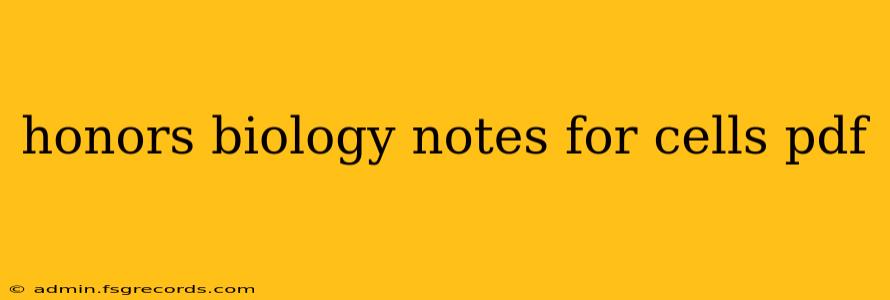These notes aim to provide a comprehensive overview of cell biology for Honors Biology students. We'll explore the intricacies of cell structure, function, and the processes that govern their existence. This isn't just a summary; it's a detailed exploration designed to enhance your understanding and prepare you for success in your course.
I. Introduction to Cell Biology: Unlocking the Building Blocks of Life
Cells are the fundamental units of life, the microscopic powerhouses driving all biological processes. Understanding their structure and function is paramount to grasping the complexities of living organisms. This section lays the groundwork for our deeper exploration.
A. The Cell Theory: A Cornerstone of Biology
The cell theory, a cornerstone of modern biology, posits three core principles:
- All living organisms are composed of one or more cells.
- The cell is the basic unit of structure and organization in organisms.
- Cells arise from pre-existing cells.
These principles, developed over centuries of scientific investigation, provide a framework for understanding the unity and diversity of life.
B. Types of Cells: Prokaryotic vs. Eukaryotic
Cells are broadly classified into two categories: prokaryotic and eukaryotic. Understanding their differences is crucial for comprehending the evolutionary trajectory of life on Earth.
-
Prokaryotic Cells: These simpler cells lack a membrane-bound nucleus and other membrane-bound organelles. They are characteristic of bacteria and archaea. Their genetic material is located in a region called the nucleoid.
-
Eukaryotic Cells: These more complex cells possess a membrane-bound nucleus containing their genetic material, as well as a variety of other membrane-bound organelles, each with specialized functions. Eukaryotic cells are found in plants, animals, fungi, and protists.
II. Exploring the Eukaryotic Cell: A Detailed Look Inside
This section delves into the intricate architecture of eukaryotic cells, examining the structure and function of key organelles.
A. The Nucleus: The Control Center
The nucleus, enclosed by a double membrane called the nuclear envelope, houses the cell's genetic material—DNA—organized into chromosomes. It also contains the nucleolus, a site of ribosome synthesis. The nuclear pores regulate the transport of molecules between the nucleus and the cytoplasm.
B. Ribosomes: Protein Factories
Ribosomes are the protein synthesis machinery of the cell. They are composed of ribosomal RNA (rRNA) and proteins and can be found free in the cytoplasm or bound to the endoplasmic reticulum.
C. Endoplasmic Reticulum (ER): A Manufacturing and Transport Hub
The ER is a network of interconnected membranes extending throughout the cytoplasm. It exists in two forms:
-
Rough ER (RER): Studded with ribosomes, the RER synthesizes and modifies proteins destined for secretion or insertion into membranes.
-
Smooth ER (SER): Lacks ribosomes and plays a role in lipid synthesis, detoxification, and calcium storage.
D. Golgi Apparatus: The Processing and Packaging Center
The Golgi apparatus, a stack of flattened membrane sacs, receives proteins and lipids from the ER, further processes them, and packages them into vesicles for transport to their final destinations.
E. Mitochondria: The Powerhouses of the Cell
Mitochondria are the sites of cellular respiration, the process that generates ATP, the cell's primary energy currency. They possess their own DNA and ribosomes, reflecting their endosymbiotic origin.
F. Lysosomes: The Recycling Centers
Lysosomes contain hydrolytic enzymes that break down cellular waste, debris, and pathogens. They maintain cellular homeostasis by recycling cellular components.
G. Vacuoles: Storage and Maintenance
Vacuoles are membrane-bound sacs that store water, nutrients, and waste products. Plant cells typically have a large central vacuole that contributes to turgor pressure.
H. Chloroplasts (Plant Cells Only): The Sites of Photosynthesis
Chloroplasts, found only in plant cells and some protists, are the sites of photosynthesis, the process by which light energy is converted into chemical energy in the form of glucose. Like mitochondria, they have their own DNA and ribosomes.
I. Cytoskeleton: The Cell's Structural Framework
The cytoskeleton, a network of protein filaments, provides structural support, facilitates cell movement, and plays a role in intracellular transport. It consists of microtubules, microfilaments, and intermediate filaments.
III. Cell Membrane: The Gatekeeper
The cell membrane, a selectively permeable barrier, regulates the passage of substances into and out of the cell. Its structure and function are critical for maintaining cellular homeostasis. Understanding membrane transport mechanisms (passive and active transport) is crucial here.
IV. Cell Communication: Intercellular Connections
Cells communicate with each other through various mechanisms, including direct contact, chemical signaling, and gap junctions. Understanding these processes is fundamental to comprehending tissue function and organismal coordination.
V. Cell Cycle and Cell Division: Growth and Reproduction
The cell cycle is a series of events that leads to cell growth and division. Understanding mitosis and meiosis, the processes of cell division, is essential for grasping inheritance and genetic variation.
This detailed outline provides a robust framework for your Honors Biology notes on cells. Remember to consult your textbook and class materials for further clarification and detailed explanations of each topic. Good luck with your studies!

